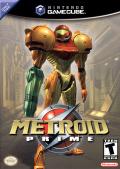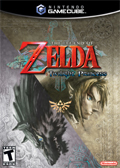
Published by Nintendo, Developed by Retro Studios
Genres: Action / Adventure (1 players)
US release date: Nov 17th, 2002 | EU release date: Mar 21st, 2003
Super Metroid's better, but this is still pretty amazing.
Review written by
Andrew Gray
With the upcoming Metroid Prime 3: Corruption coming out hopefully soon, I thought it might be a good time to reflect on why so many of us are eagerly awaiting the next installment of the franchise.
Metroid has nearly always been seen as the "black sheep" of Nintendo's franchises. It has the potential and is in some cases better than Mario or Zelda titles, but the name recognition isn't there amongst fans old and new. Personally, I had never played a Metroid title almost ever, and had only heard of it due to Nintendo Power. Because of a magazine article that proclaimed Super Metroid as "the greatest game of all time" however, I knew then and there that I had to play it somehow. Due to a lucky break, I managed to acquire a copy and it was so good that only Super Mario Brothers 3 and Chrono Trigger could be better.
Naturally, when I heard about Metroid Prime, I was both anxious and doubtful. Could they really translate Metroid into 3D very well? Many franchises suffered in the transition (Sonic, Rygar etc) and I was a little worried. Did they succeed? In a word, yes.
The last Metroid is in captivity. The galaxy is at... Oops! Wrong game!
Though visually Metroid Prime is light years ahead of Super Metroid, the actual game itself takes place only a little bit after the very first Metroid game for NES. Mother Brain has supposedly been defeated, as well as Ridley, Kraid and a good portion of the Space Pirates. Rather than be another story about the pirates and their plans for Metroids though, Metroid Prime takes a distinctly more refined approach in its storytelling.
This time around, Samus (as usual) investigates a fleet of pirate vessels made up of the remnants from Planet Zebes. After exploring the station, she discovers that Ridley has somehow been resurrected in a more powerful form. She follows him to the planet Tallon IV, another of the many worlds "touched" by the Chozo, and discovers a devious plot being concocted by the Space Pirates involving the usage of a mysterious substance called Phazon, which is not unlike a combination of steroid drugs and nuclear material. More is involved, but I'd rather not spoil it for those who haven't played the game yet.
The game has little to no cut scenes, but what it does have is atmosphere. Prime feels like an extension of the Aliens franchise at times, as you discover the story through logs and lore spread throughout, eventually coming to understand just what is taking place on Tallon IV. I don't know why, but in some ways I honestly prefer this type of storytelling, especially because it feels like you the player are reading it instead of Samus.
Power beam, Wave beam, Ice beam, Plasma beam? wait, where's the Spazer?
Part of what makes Prime great is that it keeps the overall Metroid gameplay intact. Samus starts off with nothing but a dinky blaster, but as she continues her trek through Tallon IV, she gains a host of power ups to help in the adventure. This constant search gives more purpose, but it probably would be almost as fun if the game were nothing but exploring a strange and interesting planet. While most of these power ups are familiar to Metroid fans, some power ups have either been altered or there are new ones entirely for this adventure.
Because the game is seen through Samus' visor, the player is given a better version of the X-ray scope from Super Metroid, and a brand new Heat Visor for example. That being said, there are also the required hidden Energy tanks and Missile Upgrades scattered throughout. While most aren't too difficult to find, some will take quite a bit of doing and backtracking. Fortunately, the backtracking is usually done in some form of an alternate route, making even backtracking fun.
To boldly go where no man has gone before.
Part of what gives Prime its overall charm is its aesthetic looks. Normally graphics are only usually employed in a game to give people some eye candy, but in Prime they actually serve a purpose. Without the amazing graphics that Retro was able to employ in the game (for the time) I often felt not that I was in a game, but was actually a space explorer on some uncharted planet, looking to uncover all of its secrets. Prime starts off in a fairly desolate ruin of the Chozo, and although it could have stopped with only ruinous scenery, the area is filled with dead or wild plants, dangerous insects, poisonous waters, and many hieroglyphics, giving you the impression of being in a South American ruin, or simply an ancient ruin in general. The area culminates with a giant plant monster, the source of the pollution and a rather spectacular finish. Eventually, the player comes across a series of underground volcanic caverns, a snowy mountainous region, and the remnants of the pirate vessel from the game's beginning, and eventually a series of mines in which Phazon itself is mined, all of which feature spectacular boss fights. The game concludes with a spectacular battle against the titular Metroid Prime itself, which again, I won't spoil.
Follow the bouncing ball!
About seventy percent of the game is exploration based involving the player seeing through the eyes of Samus. The other thirty consists of using the Metroid staple, the morph ball. The perspective switches to the third person, and surprisingly, this form handles almost identically to an actual ball. While at first the Morph ball seems like something added in order to only provide some variety, eventually you'll most likely be having fun riding various half-pipes, performing bomb jumps and zooming along the landscape. The morph ball IS a great addition, but thankfully, the designers didn't overuse it.
Nine pillars of tedium.
With all the great things that Metroid Prime features, you'd think there would be nothing wrong with it. Unfortunately, this simply isn't the case. Possibly the game's only flaw is a major one, namely an attempt to extend the game. Once Samus has obtained almost every item in the game and become much stronger, the designers charge the player with finding nine Chozo keys which are the only way to open up the way to Metroid Prime. The sad thing is that the clues provided to find these keys are vague at best, and most people who have beaten the game had to resort to strategy guides in order to finish this part; as if that weren't enough, the backtracking in these parts to find the keys is not as fun as the alternate routes described above and a lot of frustration can result. This seems to be the result of wanting to lengthen the game during the almost gameless periods the Gamecube went through, but Retro seemed to forget something crucial: people love going through Metroid fast! Heck, Super Metroid can be finished in less than twenty minutes. So with Prime 3, try to remember this little fact, okay and stop the stupid keys!
See you next mission!
Although Metroid Prime is now more than four years old, that should be no means deter you from trying out this excellent game. Not only is it an amazing Metroid title for fans, but it's a great introduction to the series as a whole. Just be prepared to either read a walkthrough online or endure quite a lot of frustration in the later parts of the game. Otherwise, nothing should deter you from trying this excellent game.
And hopefully, Nintendo will get off its lazy butt and finish Prime 3.
Gameplay: 
Graphics: 
Sound: 
Lifespan: 
 Shrek Smash and Crash
Shrek Smash and Crash
Activision
 The Legend of Zelda: Twilight Princess
The Legend of Zelda: Twilight Princess
Nintendo
Released on November 26th, 2006
 Flushed Away
Flushed Away
D3
Released on November 24th, 2006
tonysburger said:
you could probably learn how to make a waffle maker in there ...
T3Knyne said:
Ts university tuff ...
spleefian said:
acting like this is even active at all but i just really dislike it sideways because to me it just looks incomplete ...
spleefian said:
seeing literally just "1 decade ago" is scary to me like id be used to it saying you know 12 or 13 years ago but just ...
spleefian said:
i wish i couldve been here during this sites heyday ...
Wii's World is not officially affiliated with Nintendo! (but they wish we were).
User comments
No posts yet for this game. Be a pioneer.